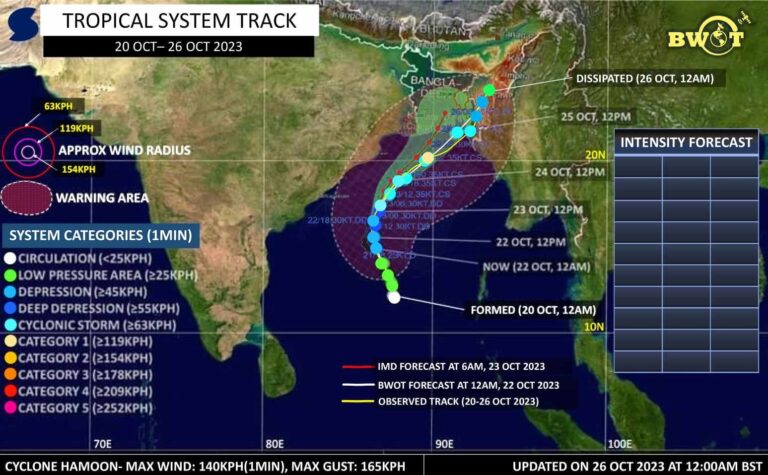
How to Predict a Tropical Cyclone? Best Tips for Cyclone Prediction
Cyclones, also known as hurricanes or typhoons depending on their geographic location, are among the most devastating natural phenomena. Predicting these powerful storms is crucial for minimizing their impact on human life and property. Knowing How to Predict a Tropical Cyclone is a better way to save lives and properties.
This article delves into the science and methodologies behind cyclone prediction, examining the tools, data, and techniques used by meteorologists to forecast these weather events.
First Understand Cyclones
A cyclone is a large-scale air mass that rotates around a strong center of low atmospheric pressure. Cyclones are characterized by their wind patterns, heavy rainfall, and potential to cause significant damage.
They typically form over warm ocean waters, where the combination of heat and moisture provides the energy needed for their development.

The Science of Cyclone Formation
To predict cyclones, it’s essential to understand how they form. The key factors involved in cyclone formation include:
1. Sea Surface Temperature (SST): Warm ocean waters (typically above 26.5°C or 79.7°F) are crucial for cyclone development. The heat from the ocean surface provides the energy needed for the storm.
2. Atmospheric Instability: This occurs when warm, moist air at the surface rises and meets cooler air aloft, creating a conducive environment for thunderstorms and cyclonic activity.
3. Coriolis Effect: The Earth’s rotation causes the Coriolis effect, which helps in the rotation of the cyclone. This effect is minimal near the equator and becomes more pronounced at higher latitudes.
4. Low Vertical Wind Shear: High wind shear (the difference in wind speed and direction with height) can disrupt the structure of a developing cyclone. Low wind shear allows the storm to grow and organize.
5. Pre-existing Weather Disturbance: Cyclones often develop from pre-existing weather systems such as tropical waves, low-pressure areas, or other disturbances.

Code 1: 43
Tools and Data You Need for Cyclone Prediction
Meteorologists use a combination of observational data, satellite imagery, and computer models to predict cyclones. The primary tools and sources of data include:
1. Satellites: Satellites provide critical information on cloud patterns, sea surface temperatures, and atmospheric moisture. Geostationary satellites, like NOAA’s GOES series, offer continuous monitoring of the Earth’s weather systems.
2. Radiosondes: These are weather balloons equipped with instruments that measure temperature, humidity, and pressure at various altitudes. The data collected helps in understanding the atmospheric profile.
3. Buoys and Ships: Ocean buoys and ships equipped with meteorological instruments provide real-time data on sea surface temperatures, wave heights, and wind speeds.
4. Weather Radar: Doppler radar systems can detect precipitation intensity and wind patterns within storms, offering insights into their structure and movement.
5. Numerical Weather Prediction (NWP) Models: These computer models simulate the Earth’s atmosphere using mathematical equations. The most commonly used NWP models for cyclone prediction include the Global Forecast System (GFS), European Centre for Medium-Range Weather Forecasts (ECMWF), and the Hurricane Weather Research and Forecasting (HWRF) model.

Steps in Cyclone Prediction
The process of predicting a cyclone involves several key steps:
1. Detection: Early detection of cyclones is vital. Meteorologists monitor satellite images and other observational data for signs of developing storms. Features such as organized convection, rotating cloud patterns, and low-pressure areas are indicators of potential cyclone formation.
2. Tracking: Once a cyclone is detected, tracking its movement is crucial. Meteorologists use satellite imagery, radar data, and computer models to monitor the storm’s path. The track is influenced by factors like steering winds, atmospheric pressure systems, and the Coriolis effect.
3. Intensity Forecasting: Predicting the intensity of a cyclone involves assessing its current strength and estimating future changes. Factors such as sea surface temperature, wind shear, and moisture content play a role in intensity forecasting. Models like the Statistical Hurricane Intensity Prediction Scheme (SHIPS) are used to predict changes in cyclone strength.
4. Model Integration: Meteorologists use an ensemble of models to improve the accuracy of cyclone predictions. Each model has its strengths and weaknesses, and by combining multiple models, forecasters can generate a more reliable prediction.
5. Public Communication: Effective communication is essential to ensure that people in the path of a cyclone take appropriate action. Meteorological agencies issue warnings, advisories, and updates to inform the public about the storm’s expected impact.
Code 2: 51
Challenges in Cyclone Prediction
While you know How to Predict a Tropical Cyclone, It is important to keep in mind the uncertainty in the cyclone prediction. While significant advancements have been made in cyclone prediction, challenges remain:
1. Rapid Intensification: Predicting rapid changes in cyclone intensity is difficult. Factors contributing to rapid intensification are complex and not fully understood.
2. Track Forecasting Errors: Small errors in predicting the cyclone’s track can lead to significant deviations in its landfall location, impacting preparedness and response efforts.
3. Data Gaps: There are often gaps in observational data, especially in remote ocean areas. Improving data collection through more comprehensive satellite coverage and deploying additional buoys can help address this issue.
4. Model Limitations: Despite advances in numerical modeling, limitations in computational power and the understanding of atmospheric processes can affect the accuracy of predictions.

The Future of Cyclone Prediction
Advances in technology and research continue to enhance cyclone prediction capabilities. Future developments include:
1. Improved Models: Ongoing research aims to refine numerical models, incorporating more detailed representations of atmospheric processes and interactions.
2. Artificial Intelligence (AI): AI and machine learning techniques are being explored to improve the accuracy of cyclone predictions by analyzing vast amounts of data and identifying patterns.
3. Enhanced Observations: New satellite missions, such as the Geostationary Operational Environmental Satellite-R Series (GOES-R), provide higher resolution data and more frequent observations.
4. International Collaboration: Collaborative efforts between meteorological agencies worldwide facilitate the sharing of data and expertise, improving global cyclone prediction capabilities.
Read More:
Hurricane Beryl Precaution, Impact and Records in Atlantic Basin
Monster Typhoon Tip : The Record-Breaking Superstorm
Strongest Earthquakes of All Time (10+)
Conclusion of the Article
To know How to Predict a Tropical Cyclone, remember these tips. Predicting cyclones is a complex and dynamic field that combines meteorological science, technology, and effective communication.
While challenges remain, advancements in observational tools, numerical models, and data integration are continually improving the accuracy and reliability of cyclone forecasts.
By understanding the science behind cyclones and leveraging cutting-edge technology, meteorologists can better predict these powerful storms, ultimately saving lives and reducing the impact on communities.
Advertisements

